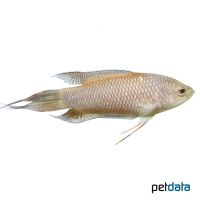Red Backed Paradise Fish (Macropodus erythropterus)
| Red Backed Paradise Fish Macropodus erythropterus | |
|---|---|
| Name | Red Backed Paradise Fish |
| Name Lat. | Macropodus erythropterus |
| Family | Gouramies |
| Family lat. | Osphronemidae |
| Order | Labyrinth Fishes |
| Order lat. | Anabantiformes |
| Origin | Vietnam |
| Habitat | Mountain streams |
| Diet | Carnivore |
| pH | 6.5-7.5 |
| Behavior | ♂ territorial |
| Keeping | Pair, harem |
| Care Level | Easy |
| Reproduction | Bubble nest builder |
| Breeding | Simple |
| Life Span | 3-5 years |
| Protection | No |
| Metric Units | |
| Size | 8-10 cm |
| Temperature | 18-26 °C |
| Hardness | 5-15 °dH |
| Aquarium | ~ 150 l |
| US Units | |
| Size | 3"-4" |
| Temperature | 64-79 °F |
| Hardness | 89-267 ppm |
| Aquarium | ~ 40 gal |
Distribution and habitat
The range of the red-backed macropod is the hill country in central Vietnam. There they live in often weedy, shady streams and small rivers, with partly overhanging riparian vegetation and muddy bottoms with sunken roots and branches. 
Maintenance
The aquarium should have a dense border planting with many hiding places (roots) and provide sufficient swimming space. A dark substrate covered with some foliage (sea almond tree, oak), subdued light (floating plant cover) and a weak current is ideal.
No ammonia, ammonium and nitrite should be detectable, the nitrate value should not exceed 100 mg/l. To ensure the water quality and oxygen content, a filter and heater adapted to the aquarium size is required, as well as lighting for the species-appropriate day-night rhythm of the animals.
Diet
In nature they feed mainly on insect larvae and plankton. The food supply consists of live, frozen and dry food. For a balanced diet, feed once a day with a high-quality dry food (flakes, granules, pellets) as well as cyclops, daphnia, artemia, tubifex, mosquito larvae, etc. (live or frozen)
Only feed as much as will be eaten within a few minutes. A regular and varied diet promotes health and increases resistance.
Behaviour and compatibility
They should be kept in pairs or better in a harem, one male with several females. Males have a pronounced territorial behavior among themselves and defend their territory consistently. Keeping several harems is only possible in a large, richly structured tank. In a community tank with many hiding places they can be kept with not too small, robust fish
Basically, only mutually compatible fish species with similar demands on water quality and water temperature may be socialized.
Sex dimorphism
The male has longer extended fin tips and is usually more splendidly colored than the plumper female.
Reproduction and breeding
The male builds a foam nest, usually involving plant parts, and also takes care of the brood. The eggs (300-500) ejected during the numerous matings (entwinements) rise to the water surface, are collected by the male and introduced into the nest. The larvae hatch after 24-36 hours and swim freely after 2-6 days.
The fry must be fed several times a day with special rearing food (dust food, Artemia nauplii). In a community tank breeding is hardly possible, because the spawn is easy prey.
Important
They have an additional respiratory organ, the so-called labyrinth (suprabranchial organ) with which they breathe atmospheric air and can suffocate if this is not possible. The air temperature in the breathing area must not be below the water temperature!
They like to jump, so the aquarium should be well covered. Other fish of similar shape and coloration are usually perceived as enemies.
The well-being of the fish should be checked regularly. Temperature should be checked daily, pH, hardness and nitrate levels at least every 14 days. Regular partial water changes are recommended, even if the contaminant level has not yet reached the upper limit. Sudden changes in water quality should be avoided. Newly introduced fish must be accustomed slowly to the water in the aquarium.
Further literature can be found in your pet store.
References
Text: Werner Winter; Image: petdata
Source: BMELV (1998): Tierschutzgutachten - Haltung von Zierfischen (Süßwasser); ENGELMANN (2005): Zootierhaltung - Tiere in menschlicher Obhut: Fische, Verlag Harri Deutsch
- Gemäß § 21 Abs. 5 Tierschutzgesetz idgF
